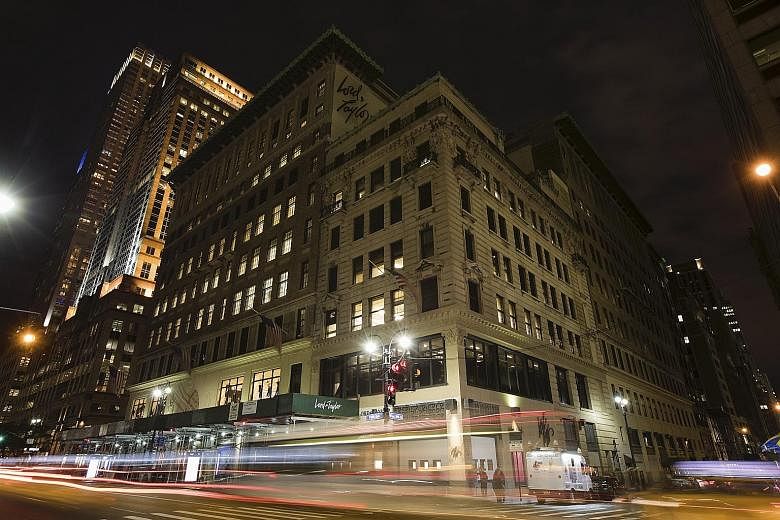The pandemic is expected to drastically reshape commercial real estate, leaving thousands of vacant and underused spaces nationwide. But some developers and investors are keen to seize the chance to convert those properties into other uses.
Lord & Taylor's flagship department store in Manhattan, for example, will soon house office workers for Amazon, and a tourist destination in the heart of Hollywood is getting a US$100 million (S$136 million) facelift that includes converting underused retail spaces into offices.
"Nobody ever lets a crisis get in the way of creating opportunity," said Ms Sheila Botting of Avison Young, a commercial real estate services firm in Toronto.
In retail alone, at least 7,700 stores totalling 115 million sq ft were expected to close this year as of early last month, according to data provided by CoStar Advisory Services. Most of these closures will be in malls, which were struggling long before the pandemic pushed department stores such as JCPenney, Neiman Marcus and Sears into bankruptcy.
At the same time, 172.7 million sq ft of Class A office space, typically the highest quality, is expected to come online this year and next. Only 59 per cent of it has been leased, below the average of 74 per cent, according to the CoStar data. And nearly one in four hotels nationwide faces possible foreclosure as owners fall behind at least a month on loans, the American Hotel & Lodging Association said.
Simply put, a lot more space is going to be available out there.
Also, businesses that use offices have been pulling back on space amid rising digitalisation and other efficiencies, as well as demographic shifts - younger generations in general are comfortable with less office space.
The commercial real estate industry's rule of thumb in the 1980s was 200 to 300 sq ft per employee, according to Moody's Analytics. By last year, the average had fallen to 126.5 sq ft.
And industries as diverse as real estate, media, technology and banking have been flirting with more telecommuting for decades. Moreover, a sizeable chunk of leased space goes largely unused during the workday anyway - estimates place it at 30 per cent to 40 per cent - as people are out of the office for various reasons.
But the crisis has created a chance for some developers to reassess their strategy.
"This represents a moment in time to think about current assets, how they're being used and what future options might be," Ms Botting said.
The starkest example yet of this approach might be Amazon's possible plans to convert JCPenney and Sears stores in shopping centres owned by mall operator Simon Property Group into distribution warehouses.
The e-commerce giant is also behind the overhaul of the shuttered Lord & Taylor store on Fifth Avenue, turning 676,000 sq ft into office space for about 2,000 employees by 2023.
Developers also see an opportunity in converting hotels into continuing care retirement communities. Mr David Reis, chief executive of Senior Care Development in Harrison, New York, said it is less expensive to convert a property than build from the ground up.
Despite the potential for lower costs and the emerging universe of options, commercial real estate conversions do pose challenges. Zoning and technical design can stymie some changeovers.
Traditionally, the best conversions have increasingly been obsolete properties.
"Typically, if they're older and they've gone beyond their useful life - reduced occupancy, reduced cash flow - they are ripe for transformation," Ms Botting said.
But even newer properties are on the table. Neiman Marcus opened a 188,000 sq ft flagship store at Manhattan's Hudson Yards just last year as the anchor retail tenant in the nation's largest private real estate development.
Now, the Related Companies, owner of Hudson Yards, is pivoting. Mr Philippe Visser, president of Related Office Development, said the store would become "the most exciting office opportunity in New York City". The move harks to previous crises that forced a metamorphosis in commercial real estate.
In the 1990s, Lower Manhattan was racked by high office vacancies and population drain, and Mr William Rudin, president of New York landlord Rudin Management, helped lead efforts to rejuvenate the area. From 1995 to 2001, more than 4.6 million sq ft was converted - including glassy office buildings no one thought would make decent apartments.
"When things get bad enough," Mr Rudin said, "it forces people to come together and come up with ideas."
NYTIMES

